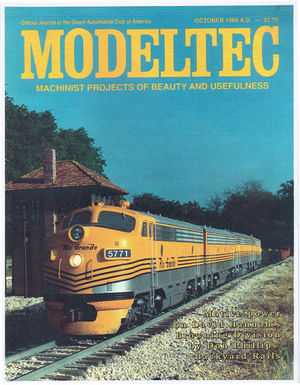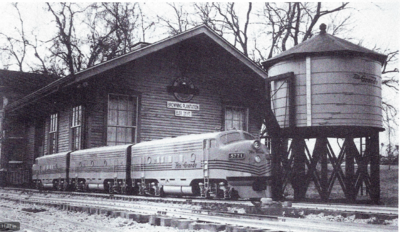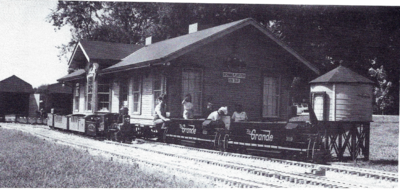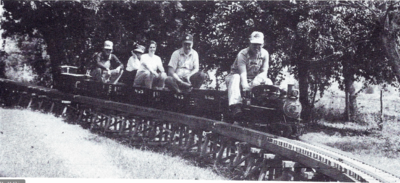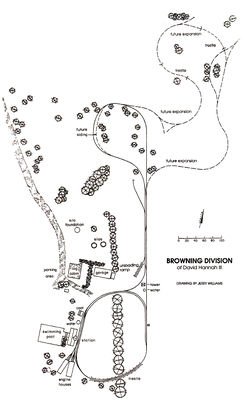Browning Railroad: Difference between revisions
(→1988) |
(→1988) |
||
| Line 160: | Line 160: | ||
File:BrowningPlantationStation awaiting departure Oct1988.PNG|Diesels #3119 and #5231 on the outside are ready for a run, while on the inner track George Maddox's 2-1/2 inch scale 2-4-2 waits for an engineer at the [[Browning Railroad|Browning Plantation Station]]. The two engine houses are visible in the background. | File:BrowningPlantationStation awaiting departure Oct1988.PNG|Diesels #3119 and #5231 on the outside are ready for a run, while on the inner track George Maddox's 2-1/2 inch scale 2-4-2 waits for an engineer at the [[Browning Railroad|Browning Plantation Station]]. The two engine houses are visible in the background. | ||
File:BrowningRailroad LaborDayMeet1987.PNG|Approaching the station, [[David Hannah III|David Hannah]] guides Fred Springer's engine across the trestle. In the cars behind him are [[Jim Jackson]], Sheryl Pillegi, Dale Spring, and Fred Springer. The photo was taken at the first meet on the [[Browning Railroad|Browning Division]] on Labor Day 1987 by David Hannah, IV. | File:BrowningRailroad LaborDayMeet1987.PNG|Approaching the station, [[David Hannah III|David Hannah]] guides Fred Springer's engine across the trestle. In the cars behind him are [[Jim Jackson]], Sheryl Pillegi, Dale Spring, and Fred Springer. The photo was taken at the first meet on the [[Browning Railroad|Browning Division]] on Labor Day 1987 by David Hannah, IV. | ||
File:BrowningDivision layout Oct1988.jpg | |||
</gallery> | </gallery> | ||
Revision as of 20:40, 30 September 2015
1988
Browning Division is site for some Texas-Style Railroading
Modeltec, October 1988
The squeal of steam whistles floated across the plantation fields, perhaps taking old-timers back to the first half of the century when the Santa Fe steam engines announced their approach to the crossings in this part of south central Texas. These modern-day sounds were coming from the two locomotives I had acquired in late 1987: a heavy Pacific and an Allen Ten Wheeler.
The two engines, along with two diesels, pulled four trains. They provided rides for some 450 people attending the Browning Plantation's second annual hog-killing party in January, 1988. They ran from morning to evening. By this date, after two years of construction, we had laid approximately one mile of track around the grounds of the plantation in the configuration shown in the map below. The system includes an 800 foot outer loop enclosing an inner loop, both of which come together at a 138 foot long bridge through the use of a gauntlet track. Taking off from the northeast corner of the main loop through the connection of a wye, two parallel tracks then head north. There are three crossovers before the tracks reach a balloon loop with a siding attached. This north loop is approximately 750 feet in length and it allows us to run trains bi-bidirectionally if we wish to do so.
The station was constructed using model plans of the Santa Fe construction book. With two bedrooms and two baths it serves as a guest house for the Browning Plantation, provides restroom facilities, and may be used as dressing rooms for people who swim in the nearby pool In addition to its bedrooms and baths, there is a mini-kitchen which, with the station's waiting area, is useful as a dispatcher's office for bi-directional operations.
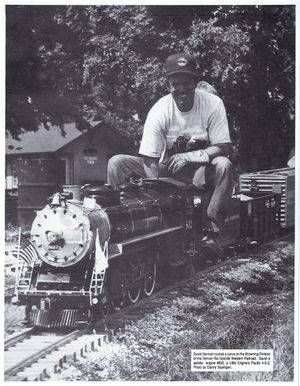
Directly south of the station are two engine houses where most of the equipment is stored. One is 10 feet in width, the other 12 fee, and both are 36 feet long. Each has five tracks, with three tracks connected to the main line. With approximately 360 fee of track covered. I hope that these houses will accommodate all of the equipment that will be coming in the future.
The present equipment operated by the Browning Division includes the No. 20 Allen Ten Wheeler recently renumbered 723, and a heavy Pacific No. 832 built by Johnny Smyth of Hot Springs, Arkansas. Presently, I am building a Railroad Supply Mikado, expecting to receive its boiler soon so that it can be completed before the end of the year. We acquired two diesel engines in January, 1987 -- an SD35 and a GP50 from Backyard Rails. In March, 1987, we obtained a GP40 dummy built by Railroad Supply Corporation, and, in January of this year, we took delivery on a second SD35, also from Railroad Supply. This latter engine is under reconstruction to be changed to a GP40 with four-wheel trucks instead of six-wheel. In February, 1988, we received an F7 A-B-A combination diesel engine set lettered in Rio Grande colors by [[Backyard Rails]].
The rolling stock consists of 14 gondolas, five flat cars, two box cars from Railroad Supply Corporation, and four reefers from Mercer Locomotive Works. We have one Mountain Car Company passenger car on hand with two more expected, and three more passenger cars are on order from Railroad Supply Corporation. It is anticipated that the passenger cars will be operated behind the Mikado and Pacific steam engines, with most of the freight cars being pulled by the diesel engine. To go along with the rolling stock there are approximately half a dozen cabooses.
Before starting to lay the first tracks at Chappell Hill, I had attended a number of meets held by the Southwestern Live Steamers at sites in Wimberly, Devine, and Manor, Texas. From these visits I learned that I wanted a layout with large-radius curves, good track work and, especially, a good base. There should be at least 30 to 36 ties per 10 feet of track and, if possible, the ties should be at least 15 inches or 16 inches long. In constructing the right-of-way at the Browning Division, we first put down 3 to 4 inches of limestone as a base material. This was laid over black plastic which was held in place with treated 1x4's for trim material. On top of this we assembled all of the track which was elevated after we hauled in the ballast. The result is that the top of the rail is at least 8 inches above the natural ground, thus providing good drainage.
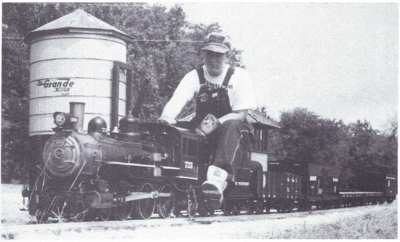
I faced a challenge in building the original loop. The elevation of the station was about 6 feet higher than the ground at the southeastern most part of the loop. To compensate, a bridge was built at the south part of the loop to elevate the track at least 2 feet above the ground with fill on the bridge approaches. Even with an 800 foot loop, there was still a 4% grade running trains counterclockwise where they came through the wye back to the station off of the east fence line. Today we run trains clockwise through the main loop going to and from the station.
In the fall of 1986 dirt was hauled in, the base prepared, and track laid. During Christmas/New Year the bridge was built. The last section of the loop was laid on Super Bowl Sunday, 1987.
Between 300 and 450 people turned up for the Browning Plantation's first sausage-making part of 1987 and to ride the trains. This put great stress on the track and the equipment. We had just one steam engine and one GP50 Backyard Rail diesel running at that time. Fred Springer's No. 20 was given the honor of being the first to run on the first loop of the track.
By the spring of 1987, a fairly large collection of cars and engines had been accumulated. A loading ramp was needed so that I would be able to transport this equipment in my pickup to run at other tracks. The wye connection was constructed to the north portion of the north loop, a ramp was built and the single-track portion of the double main line was extended northward for approximately 150 feet to allow loading the cars and engines onto my pickup or trailer.
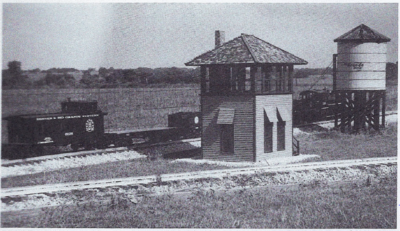
No new track was constructed until the summer of 1987. At that time additional fill dirt was hauled in in as well as approximately 32 tons of crushed limestone for building the base for the north loop. Six and eight inch drain pipe was installed to drain the front yard of the plantation house through the area. All during June and July I assembled track panels at my house in Houston and hauled about 200 feet of track to Chappell Hill every weekend. On one weekend in July we laid 657 feet of the accumulated track panels. On the last weekend of July, 1987, after putting down the final ballast and leveling the track, it was finally possible to make a complete loop of all the track in the Browning Division of the Rio Grande. Mr. George Maddox of Fort Worth had the honor of making the first loop with me and everything worked perfectly. During the next month, after all the track had been laid, we corrected some minor problems with switches. I made them spring-loaded, oiled and greased the points, and prepared the elevation of most of the frogs, making sure that we had smooth flow operation during most of the turnouts.
During the 1987 Labor Day weekend, Mr. Maddox helped put on a mini-meet with certain invited guests of the Southwestern Live Steamers. There were about seven engines in operation (both diesel and steam), and had a grand time as we finished putting the whole track into service for the first time with guests.
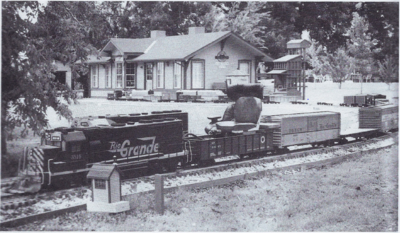
Shortly after the Labor Day meet, a big rainstorm washed out the south part of the north loop, so in October I pulled all of the damaged section out with a Bobcat and constructed a new 40 foot bridge. Some left-over fill dirt was used to shore up the support on either side of the bridge and to take care of the curves leading to the bridge. Later in 1987, a siding was installed on the north loop to permit bidirectional runs if desired.
What's in the future for the Browning Division? Construction of the Mikado engine will be completed and some of the switches will be reconstructed, changing them from number sixes to number nines. I am also exploring the possibility of taking off from the siding on the north loop past a small creek that is fed by a spring, down to the tank and back again. These extensions would encounter rather severe grades, in the neighborhood of 4% to 6%, so it would probably be necessary to cut and fill in places to reduce the grade to less than 3%. Such challenges are part of building a railroad, and overcoming them is what is so satisfying.
The Browning Plantation is a Bed and Breakfast Inn located in Chappell Hill, Texas. The railroad is privately owned and is not open to the public.
Two powered A units and a dummy B unit, all by Backyard Rails, wait at the station for passengers on the Browning Division of the Denver & Rio Grande Western Railroad.
Some of the railroad's rolling stock is visible in this photo. Locomotive #723, an Allen Models Ten-Wheeler, heads up the consist in the foreground while two Railroad Supply Corporation GP-40s, #5321 and #3119 (dummy) handle freight on the outer loop.
Diesels #3119 and #5231 on the outside are ready for a run, while on the inner track George Maddox's 2-1/2 inch scale 2-4-2 waits for an engineer at the Browning Plantation Station. The two engine houses are visible in the background.
Approaching the station, David Hannah guides Fred Springer's engine across the trestle. In the cars behind him are Jim Jackson, Sheryl Pillegi, Dale Spring, and Fred Springer. The photo was taken at the first meet on the Browning Division on Labor Day 1987 by David Hannah, IV.
1998
Last Run at the Browning Railroad
Bill Laird wrote on 5 July 2015:
- Those who ran on the Browning all share fond memories of Mildred Ganchan, mother-in-law of David Hannah, as the gracious hostess of the Browning Plantation.
